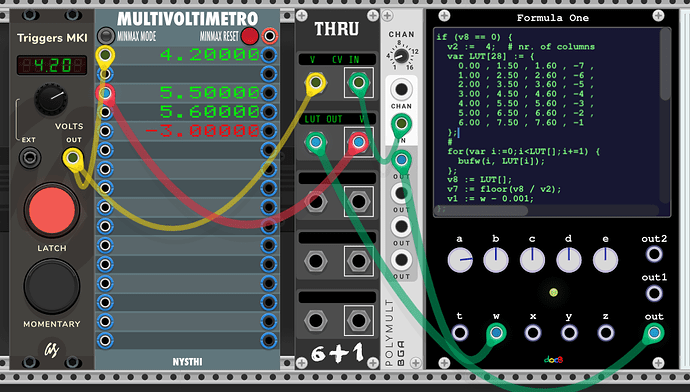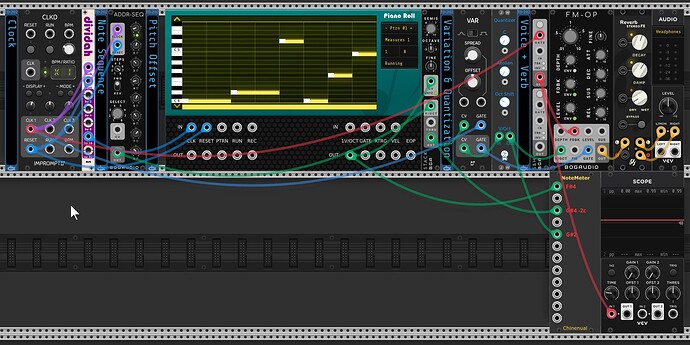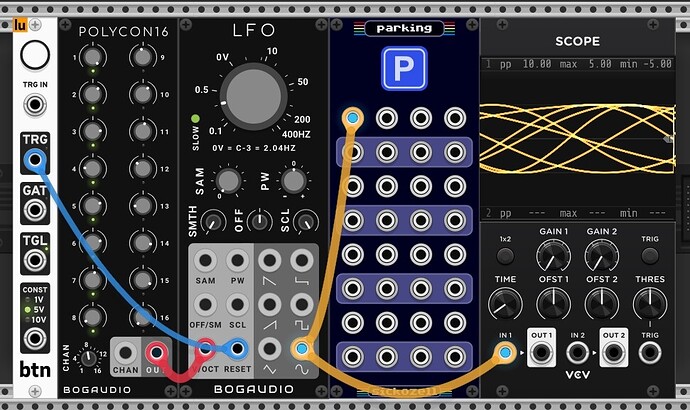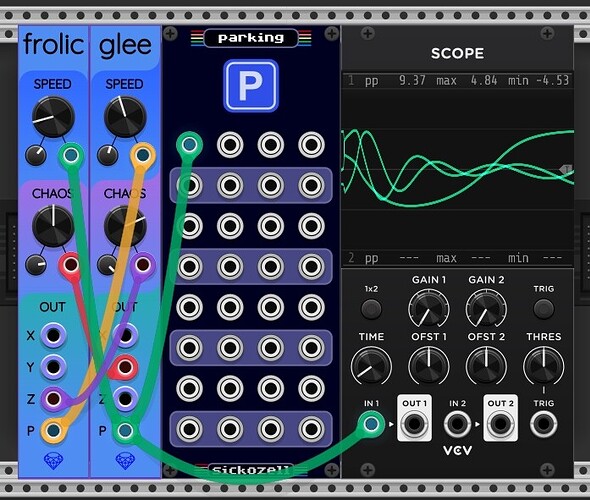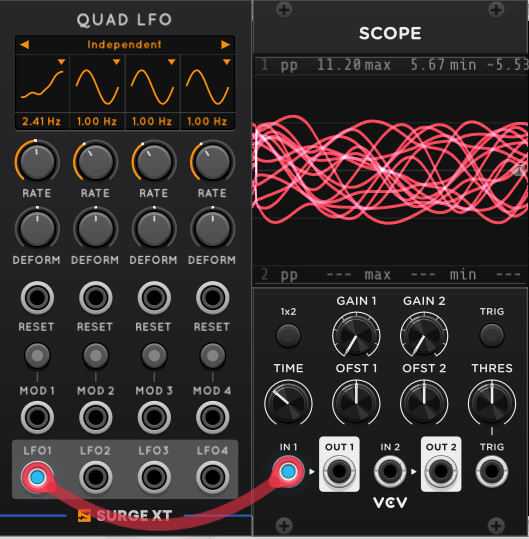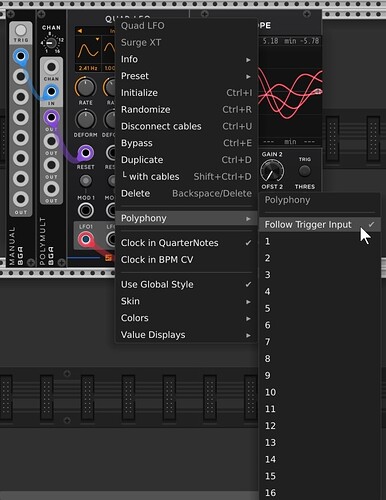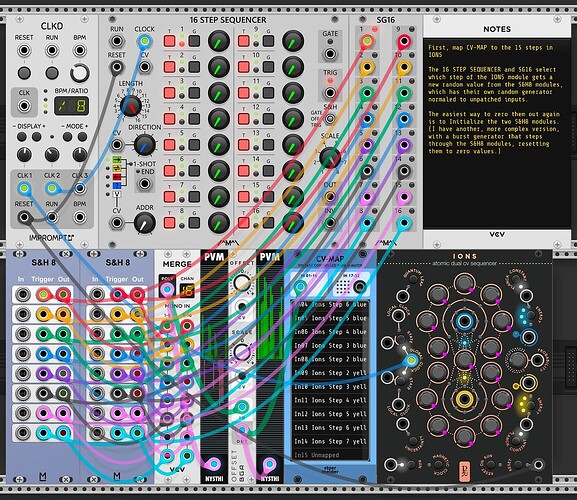There is no link, as this has to go via email to support. Simply state that you’s like to support the feature request to preserve MIDI mappings submitted yesterday by me, that should do it… I was on the fence between FR and bug, maybe state that you consider it a bug as well?
Done.
Shimmer Reverb.vcvs (10.0 KB)
Click-Free Audio Looper.vcvs (8.9 KB)
Here’s a couple I use a lot, DIY shimmer verb and a looping sub-patch with a short fade in/out. I like to loop stuff post-FX, so I can capture bits of granular delay and reverb tails without annoying clicks. Just connect whatever you want to loop into the Nysthi autoXfade inputs.
Both of them are very nice and useful, thank you!
Thanks, I’ll see what else I can dig out!
This is a useful selection I sometimes have in my patches:
lut_poly_f1.vcvs (4.1 KB)
CV LookUp Table using docB Formula One
Convert incoming CV ranges into discreet (multiple/polyphonic) output CV values using a predefined lookup table. The lookup table can be changed in the F1 code, using a list of comma separated values. Table lookup is implemented with a binary search algorithm, so it should be efficient, even for large lookup tables.
Usage:
- connect incoming CV to “w” input of F1
- connect it directly when having only one output value (remove BOG Polymult in that case)
- connect through BOG Polymult to F1’s “w” input when multiple output values in the lookup table, and set “CHAN” to the nr. of output channels
- in F1, replace “LUT” table definition with wanted values these can be values exported from a spreadsheet in Comma Separated Value (CSV) text format (note: no comma after last element!)
- first column contains input value ranges
- set “v2” to the nr. of columns in the table (= 1 + nr. of outputs)
“out” will have the looked up values from the table (can be polyphonic!)
w input values lower/higher than the first/last index value in the table will also output the first/last output values in the table
This looks great! Can you point to one or two use cases where the lookup table comes in handy?
Pitch variation for sequences
Pitch sequence variation_Piano Roll_Alphagem-O_20240403.vcvs (28.1 KB)
Pitch sequence variation_ADDR-SEQ_Alphagem-O_20240403.vcvs (24.3 KB)
The pitch of a given sequence (here 16 steps in Piano Roll by RCM, monophonic) is offset every 4 beats by another, slower Piano Roll to vary the pitch level of the melody, e.g. to follow the chords.
In addition, random noise is added to the pitch CV using Impromptu’s Variations module for an occasional note offset, yielding a very slightly altered sequence on every cycle.
A quantizer (JW) keeps notes in scale. Velocity is set in the first Piano Roll and connects to feedback on FM-OP for movement.
In a variant, a 7-step sequence is created with ADDR-SEQ and FM-OP's feedback is controlled by S&H (Bogaudio).
These are cool. Here I have Meander conducting the piano roll sequence with both in the same mode and root via Meander’s poly external scale (PES) output and the Grande Quant quantizer which can understand PES. In this, Meander is set to a diatonic PES but can be set to a pentatonic PES scale via Meander’s right click menu.It is in Am (Aeolian A)
Polyphonic LFO
Polyphonic LFO_Alphagem-O_20240405.vcvs (4.9 KB)
As shown by @VirtualModular in a recent ambient drone tutorial. Reset button added to sync LFO phases. Set overall frequency range in LFO (Bogaudio). Set number of channels in Polycon16 (Bogaudio) and randomize its output for frequency variation.
Three irregular LFOs using Glee and Frolic, polyphonic, cross-modulation
Smooth irregular LFO w. Frolic+Glee_Alphagem-O_20240405.vcvs (3.6 KB)
Outputs an irregular smooth modulation signal with three channels in a polyphonic cable. Frolic and Glee cross-modulate each other, constantly speeding up and slowing down the speed of the output. Set speed range with Speed knobs.
Cheers @Alphagem-O ! That’s my favourite trick for getting 16 LFOs from 2 modules. Here’s another tip: try the sample and hold output (top right), I use that loads if I want a quick way of getting 16 channels of S&H (Count Modula’s Super S&H is pretty good too though). I still need to check out Frolic and Glee, so thanks for uploading that - looks like an interesting mod source.
I too cherish polyphonic modulation, as it opened a whole new world for me in terms of movement.
With Polycon16 (as with many other Bogaudio modules), I like that the output range can be set in the context menu. Choosing e.g. +/- 1V can eliminate the VCA you use in your video tutorial to curb the signal.
LLFO (Bogaudio) is great, too. It handles polyphonic signals similar to LFO (Bogaudio), but has a smaller footprint. LFO adds control over pulse width, smoothing and sampling rate in the GUI, whereas these are adjusted via the context menu in LLFO.
Thank you for the tip with the stepped random! It’s very useful when you desire an S&H-like behavior without actually pulling the trigger to sample the value(s), leading to both, amplitude and time point being randomized.
In a variant, I replaced Polycon16 with a combination of Polymult (Bogaudio) and VCV’s RND module to supply random polyphonic V/Oct to LLFO. It generates up to 16 stepped random signals in a small space.
Polyphonic stepped random
One of my favorite recent discoveries is, that the SurgeXT Quad LFO can generate random values. Up to 16 channels on each of the four outputs.
Nice find!
And with ‘Follow Trigger Input’ (see pic), the number of polyphony channels can be chosen flexibly via the number of channels fed into the Reset port.
Thank you for your patch, it seems that the Piano Roll module and Meander go along really well!
Playing with this setup some more, it showed that the arp can also be directed right from the first chord note of Meander. So, in this variant, the second Piano Roll can be left out entirely.
Piano Roll Sequence with Meander-1_Variation 01_AGO_20240413.vcv (9.4 KB)
Every time I fiddle with my IONS Incremental Randomizer it gets more compact and simpler.
Originally like this:
but now the “16 STEP SEQUENCER” and “SG16” trigger expander is replaced by Bogaudio’s “SWITCH 1-16”, with the 2nd clock also going to its input. Fifteen of the outputs are merged by VCV MERGE, and the poly output of that goes into the gate input of Bogaudio’s “S&H” (replacing the two “S&H 8” modules), so that only one of the 15 channel poly output is changed at any given step of the “SWITCH 1-16”. And I’ve added a STRIP module to preserve the mapping of CV-MAP. One of the NYSTHI “PVM” meters is no longer needed, but I added a NYSTHI “2M” meter to the blue and yellow outputs of IONS. I chose “2M” because the two meters are stacked vertically, and you can select the range of input voltages.So, (soon) it will exist as a STRIP to be loaded, rather than a proper “selection”. Or maybe it should be a selection with only the STRIP module in it because I’ll always be forgetting that it’s not actually a loadable selection.
I’ll post the updated version soon.
Ive been using a midi fighter twister, and mapping them to a patchmaster intrrface with labels, then map patchmaster params to parameters to change. You can even customize ranges in patchmaster to have a fully functioning setup. I suppose you could interface the same way with whatever midi controller. (Make a patchmaster facsimile and load in with strip++)
The premapped facsimile is a selection i use all the time.
Your post inspired me to hook up my MIDI Fighter Twister and bring it into Rack. Not sure why I had never got it working before, if I tried.
So, do you have any interesting selection files for use with the fighter that you are willing to share? Or have you already and I missed it? I have PatchMaster.
Tbh most of my patches geared towards performance are done this way.
I can send patches…
Lately ive been really inspired in studio settings where ive been helping to add synth to a couple of musician friends albums…
The workflow we use is wildly inspiring.
-
We dream up the sounds This is a collaborative process but also a speedrun tone smithing project for me
-
We agree on the terms The patchmaster acts as a simplifier of the modular environment. All understand because we build it together.
-
All hands on modulation. Long form recording of multiple people turning knobs and talking while recording.
The result is human, playful, collaborative, and long form.
